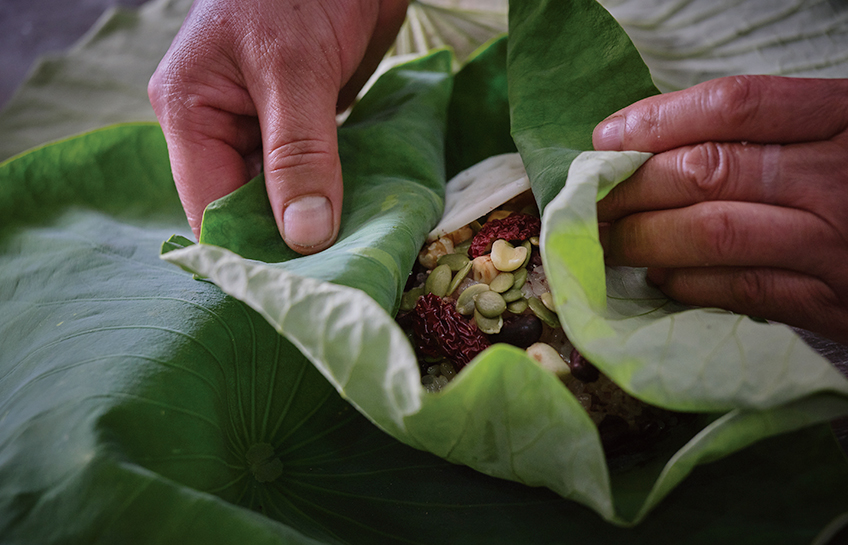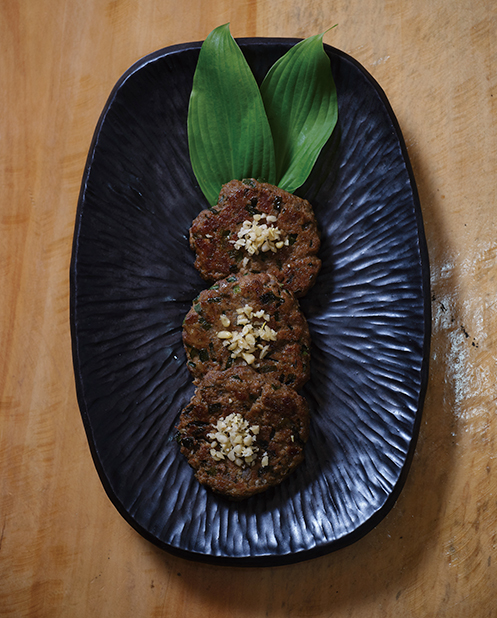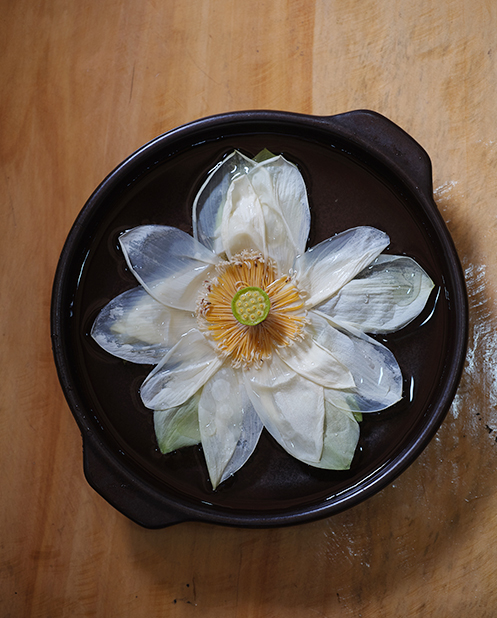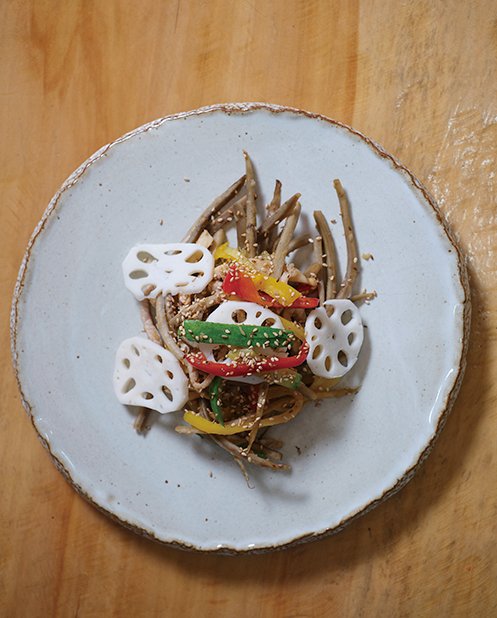
Contents





“Most Remarkable Rebellion”





Local Taste · Written by Park Jina Photographed by Studio Kenn
Blooming Flavor of
Lotus Leaf
Yeonnip-bap
Gungnamji Pond in the town of Buyeo-eup in Buyeo-gun County of Chungcheongnam-do Province is covered in gorgeous
lotus flowers every summer. Built on the site of the last capital of the ancient Baekje Kingdom, this was
the first royal garden made during the reign of King Mu of the Silla Kingdom, a time when he had a
legendary romance with Princess Seonhwa. With an abundance of fully bloomed lotus flowers in summer
at the pond, the county is famous for cuisine featuring neatly prepared dishes made with lotus.

The lotus flower, used as a county symbol, is often found everywhere in Buyeo-gun. Attesting to the county’s nickname of “Lotus Town,” the most famous dish in this area is yeonnip-bap (steamed rice wrapped in lotus leaf). Originally served at Buddhist temples, the food features the mysterious yet beautiful flower that grows in muddy water and is compared to the Buddha, representing heaven as a symbol of purity. The lotus leaf has antibacterial and preservative properties that keep food from spoiling amid heat or humidity. That’s why monks going on a long journey to seek enlightenment carried lotus leaf rice with them.
While the lotus flower represents heaven in Buddhism, it signifies pure love in the secular world. Heo Nanseolheon (1563-89), a prominent female poet in the Joseon Dynasty era (1392-1910), wrote a poem describing a woman picking lotus seeds and throwing them into the water. This came from the traditional practice of lovers giving such seeds to each other.
Nothing of the lotus flower needs to go to waste, from its leaves and flowers all the way down to its roots. It can avoid decay from hundreds to thousands of years and sprouts when proper conditions are met. The cultivation of lotus flowers from 2,000-year-old seeds shocked the world. The lotus flower is also both practical and versatile as its leaves and roots are used in cooking, its petals in tea making, and stems, seeds and skin as ingredients in recipes as well as herbal medicine.
Nutrition Wrapped in a Leaf
Attesting to its fame as the country’s largest lotus habitat, the area around Gungnamji Pond has developed a wide variety of lotus cuisine, the most famous being inarguably yeonnip-bap (steamed rice wrapped in lotus leaf). While eating this dish is as simple as peeling the leaf to consume the rice inside, making it requires a lot of time and care. The rice must first be cooked with pine nuts, walnuts, dates and chestnuts and then wrapped with a lotus leaf, steamed and simmered. The key to bringing out the strong flavor of lotus leaf in the rice lies in the process of cooking and simmering and repeating it. The use of a mature lotus leaf rather than a younger one ensures maximization of flavor. Dark spots on the leaf indicate its suitability as an ingredient.
Yeonnip-bap is especially great in summer as an energy booster in warm weather. As the leaf is peeled, steam comes out of the rice; just looking at it makes one hungry. Various grains and nuts with the mild and pleasant smell of lotus add to the experience.

Rice wrapped in a lotus leaf and steamed gives a strong flavor.
In Buyeo, yeonnip jeongsik (jeongsik means a Korean-style full-course meal) comes with side dishes made with lotus. Tteokgalbi (grilled short-rib patties) or jeon (pancake) made with lotus roots are delectable, but the highlight is the salty and sweet yeongeunjorim (braised lotus root), which pairs well with yeonnip-bap. To make yeongeunjorim, lotus root is thinly sliced and soaked in water for a bit. The slices are then cooked in boiling water and rinsed with cold water. When the water is removed, marinate and simmer in soy sauce. Yeongeunjorim’s simple recipe makes it a common side dish in Korean households.
This full-course meal concludes with lotus flower tea. A white lotus flower is used to make this tea because of its mild aroma, as that of a red lotus flower is too strong. Pour hot water into a jar or teapot wide enough to hold a blossomed lotus, while slowly opening the petals. As soon as hot water touches the flower, the tea’s sweet and rich smell will instantly fill the air and soothe the mind. This tea is also known to cleanse the blood and alleviate insomnia.
The remarkable lotus flower leaves nothing to waste; not only does it offer a beautiful look but is also an ingredient for both food and tea. Summer is a great time to experience all this flower has to offer in Buyeo.
 Tteokgalbi, made with ground pork and lotus root, is a great dish to pair with lotus leaf rice.
Tteokgalbi, made with ground pork and lotus root, is a great dish to pair with lotus leaf rice. White lotus flower is used for sweet and rich flavored tea.
White lotus flower is used for sweet and rich flavored tea. In Buyeo, a variety of lotus root side dishes with fresh vegetables are available.
In Buyeo, a variety of lotus root side dishes with fresh vegetables are available.Other Articles





“Most Remarkable Rebellion”










